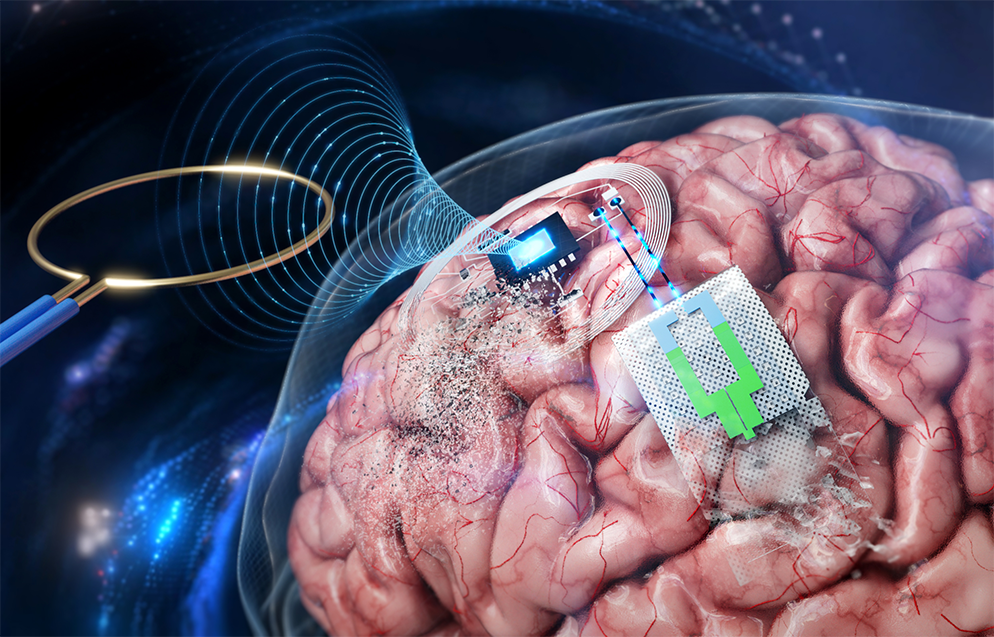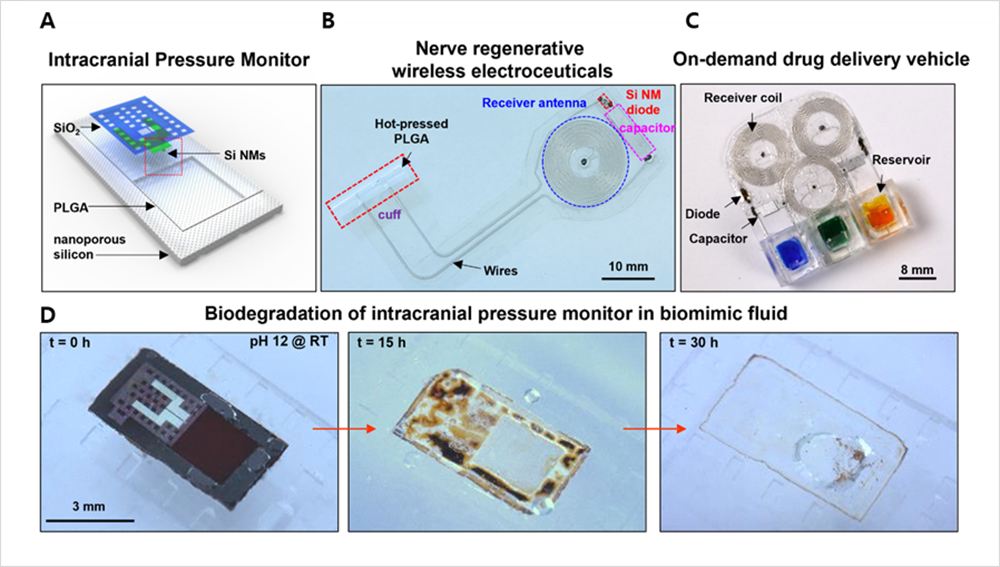In modern society, healthcare is receiving increasing global attention due to the aging population and the need for advanced medical technologies. Biointerfaced electronics have emerged as a crucial development in this field, providing real-time diagnosis and personalized medical technology by attaching to the human body. Among these, implantable medical devices have gained significant interest as futuristic medical devices, thanks to their potential for high diagnostic accuracy and targeted treatment. However, their invasiveness and tendency to remain in the body after treatment pose significant limitations, such as the risk of secondary infections and tissue damage, or the need for removal surgery.
In our pursuit of advancing the field of medical technology, we have honed our expertise in developing biodegradable and minimally invasive implants that deliver high levels of surgical care while minimizing the need for invasive procedures and associated complications. Our focus lies in creating soft and flexible electronics that enable portable medical devices, offering unprecedented mobility and convenience for patients. Our research is centered on the design, processing, and verification of medical electronic sensors and therapeutic devices that can safely decompose and be absorbed by the body while effectively regulating the chemistry and kinetics of decomposition behavior. Our team possesses extensive knowledge and experience working with a variety of biodegradable materials, including semiconductors such as silicon and silicon-germanium, dielectric materials including magnesium oxide, silicon dioxide, and silicon nitride, as well as metals including magnesium, zinc, tungsten, molybdenum, and iron.
We have leveraged biodegradable materials to develop soft, implantable hybrid electronic devices that expertly combine inorganic and organic materials. These high-performance devices can be customized to fit various shapes and movements of the human body. Our approach involves utilizing Micro-Electro-Mechanical Systems (MEMS) technology, as well as 3D printing electronics to cover a wide range of structural sensors. Furthermore, we employ transfer printing to ensure the stability of solvent reactions and appropriate processing temperatures for biodegradable materials. This enables the creation of integrated circuits, single elementary devices, and integrated levels of devices with unmatched precision and accuracy. Our unwavering commitment to improving healthcare and quality of life for patients everywhere drives our dedication to advancing the field of biodegradable electronics.
The potential applications of biodegradable electronic devices in disease diagnosis and treatment are manifold. To illustrate, we have developed an implantable wireless brain pressure sensor that can diagnose traumatic brain injury caused by local bleeding, including concussions. This device is inserted into the brain with simple surgery and disappears on its own after measuring brain pressure for approximately one week. As a result, the need for removal surgery is eliminated, and the risk of secondary infections is reduced.
Biodegradable electronic devices are also being employed for drug delivery and neuro-regenerative treatment. These devices enable wireless communication technology to be effectively utilized during repeated drug treatments or when drug treatment is required for a specific period of time. Wireless electrical stimulators represent a technology that surpasses the limited therapeutic effects of conventional surgical procedures, as they allow for postoperative treatment through wireless communication. Through continued research and development, the potential for biodegradable electronic devices to revolutionize healthcare and improve patient outcomes is immense.
The potential of biodegradable electronic devices to revolutionize healthcare is vast and far-reaching. However, it is important that research efforts not only focus on the development of minimally invasive electronic devices but also on the creation of personalized medical devices that can provide essential medical services regardless of time and place. To achieve this, we advocate for the use of three-dimensional processes in electronic device development, which enables customized treatment of organs with varying shapes in the human body and helps to overcome spatial limitations. Additionally, the reliability of medical devices is paramount for the successful commercialization of newly developed technologies. Malfunctioning medical devices can have serious implications for patient diagnosis and treatment, underscoring the need for robust and dependable devices that meet the highest standards of performance and accuracy. Through continued innovation and research, we can unlock the full potential of biodegradable electronic devices and bring about a new era of patient-centered and personalized healthcare.
References
1. S.-K.Kang et al. "Bioresorbable Silicon Electronic Sensors for the Intracranial Space and the Deep Brain", Nature 530, 71 (2016).
2. J. Koo, et al. "Wireless bioresorbable electronic system enables sustained nonpharmacological neuroregenerative therapy." Nature medicine 24, 1830 (2018).
3. J. Koo, et al. "Wirelessly controlled, bioresorbable drug delivery device with active valves that exploit electrochemically triggered crevice corrosion." Science advances 6, eabb1093 (2020).
4. L. Yin et al. "Dissolvable Metals for Transient Electronics", Advanced Functional Materials 24, 645 (2014).
5. S.-K.Kang et al. "Biodegradable Thin Metal Foils and Spin-On Glass Materials for Transient Electronics", Advanced Functional Materials 25, 1789 (2015).
6. S.W. Hwang et al. "High-Performance Biodegradable/Transient Electronics on Biodegradable Polymers", Advanced Materials 26, 3905 (2014).




